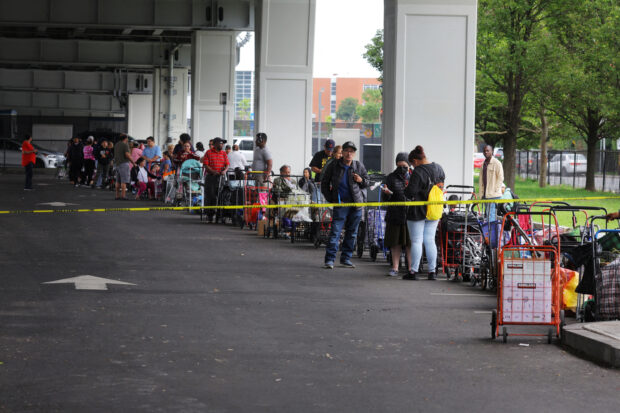
FILE PHOTO: Residents wait in line for free groceries from the twice-per-week food pantry run by La Colaborativa, a Latina-led organization founded in 1988 to serve immigrant communities around Boston, in Chelsea, Massachusetts, U.S., June 23, 2023. REUTERS/Brian Snyder/File Photo
Food insecurity is rising in the U.S. as the end of pandemic-era aid and higher food costs strain low-income Americans, according to data released on Wednesday by the U.S. Census Bureau and two surveys from anti-hunger groups.
About 26.5 million Americans reported sometimes or often not having enough to eat between June 7 and June 19, according to the Census’s latest Household Pulse Survey – up 4.4% from last month’s survey and 12% from June 2022.
The number of people who reported picking up free groceries in June was 10.9 million, down about 10% from May but up 22% from June 2022, according to the data.
Most food aid programs tied to the COVID-19 pandemic, like a nationwide waiver that allowed schools to temporarily serve meals for free, have ended. Poor households have also seen a decline in benefits from the Supplemental Nutrition Assistance Program (SNAP) program, after a pandemic provision that expanded benefits ended in March.
Propel, a company that provides financial services to low-income people, found in a survey that 31% of its users reported relying on friends and family for food in June, up from 19% in February, before the expanded benefits ended.
The USDA last week committed $2.3 billion to food purchases for schools and emergency food providers like food banks.
Food costs are up 6.7% over last year, according to the most recent data from the Bureau of Labor Statistics.
A report released Wednesday by the Food Research and Action Center (FRAC), an anti-hunger advocacy group, said the school meals waiver had helped ease hunger.
“The return to pre-pandemic operations results in too many children missing out on the nutrition they need,” Luis Guardia, president of FRAC, said in a statement.
The number of students getting school lunch fell 7% after the waiver ended, according to FRAC.